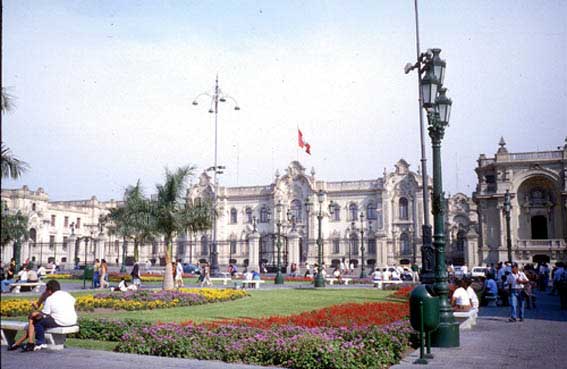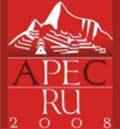United Kingdom
| Welcome |
| Peru in Brief |
| History |
| Geography |
| Government & Politics |
| Maritime delimitation between Peru and Chile |
| News |
Links |
| LIMA | |||
 |
|||
| Palace of the Government | |||
| Capital: | Lima (national capital) | ||
| Elevation: |
154m | ||
| Climate: |
Mild. Summer is December to April. | ||
| History: |
Pre-Colonial Times. The first inhabitants of the Rimac valley were an eminently religious fishing folk. They were superseded by the proto-Lima culture, whose two branches were the Maranga and the Aramburu. The valleys surrounding Lima witnessed the development of three cultural groups: the Collas, who arrived from Canta and Huarochiri, the Huanchos advancing along the Rimac, and the Huallas, who came through Carabayllo. Later, the all-conquering Incas showed respect for the buildings, customs and religion of these peoples, whose god Pachacamac was allowed to be worshipped alongside the Inca Sun deity. |
||
The Colonial Period. Lima was founded by Francisco Pizarro on January 18. 1535. but enjoyed its greatest prosperity during the 17th and 18th centuries as the focus of the Viceroyalty's political and military power. A succession of 40 viceroys occupied the Palacio de Gobierno over the 282 years of colonial rule under the Spanish dynasties of Asturias and Bourbon. During this time, too, religious life in Peru was enhanced by the saintly figures of Toribio de Mogrovejo , Rose of Lima (Patron of Peru, the Americas and the Philippines ), Martin de Porres (whose fame has extended throughout the world), |
|||
John Macias and Francis Solano . After Independence . Peru 's independence was proclaimed by General Jose de San Martin in Lima on July 28, 1821 . Under the administration of Ramon Castilla , Lima took a leading role among Latin American cities: the Lima-Callao railway was built, gas lighting and a telegraph service were introduced, and the slavery of blacks was abolished. |
|||
| Enrique Meiggs and presidents Balta, Pierola and Leguia in turn contributed to the capital's urban advancement. | |||
| Places of Interest: | Plaza Mayor. In delimiting this square the day he founded Lima , Pizarro marked the sites for the Governor's House (later renamed Palacio de Gobierno ), the Cathedral and the Cabildo or town hall (now called the Municipalidad). A bronze fountain dating from 1650 still adorns the centre of the square. |
||
The Cathedral. Originally dedicated to Our Lady of the Assumption, the church was completely destroyed by the great tremor of 1746. The viceroy Jose Antonio Manso de Velasco ordered it rebuilt in 1758. Inside, the choir stalls, the churrigueresque chapel of the Immaculate Conception and sculptures by Martinez Montanez deserve special attention. The ivory crucifix was a gift from Charles V By the entrance on the right is a chapel believed to contain the remains of the Conquistador Pizarro himself. The sacristy holds a collection of religious art objects. |
|||
Palacio de Gobierno. Popularly known as Casa de Pizarro because it was the Conquistador's designated seat of government from the time Lima was founded. The compound has residential quarters, elegant halls such as the gilded Salon Dorado and many fine paintings. A daily tourist attraction is the changing of the guard at 11:45 a.m. on the Plaza de Armas. |
|||
Church and Convent of Santo Domingo. Both date from the 16th century. The church belltower is quire remarkable in stvle. The left side altar is dedicated to Our Lady of the Rosary, while the altar on the right honours the Peruvian saints Rose of Lima, Martin de Porres and John Macias. Silver urns containing relics of the saints are placed beneath each sacred image. The convent is one of Lima 's best-preserved. (At Jr Conde de Superunda and Camana). |
|||
San Pedro. The church was built by the Jesuits in 1624. The side naves feature gilded baroque-style arcades and altars (the finest are those dedicated to St. Ignatius of Loyola and St. Lucia ) and paintings from the colonial period. The stone front is elaborately sculpted. (Jr. Azangaro, cuadra 4 and Ucayali) |
|||
San Francisco. A colonial-style complex comprising the church and convent of San Francisco and the chapels of La Soledad and El Milagro . The convent, cloisters and porter's lodge are decorated with authentic Seville tiles dating from 1620. The museum of religious art, the library and the Sala Zurbaran also warrant a visit. The Catacumbas are a series of underground passageways that served as a cemetery in colonial times. |
|||
La Merced. The stone front dates from the 18th century. The high altar is dedicated to Our Lady of Mercy, Patron of Peruvian Arms – and Field Marshal thereof. The legendary Cross of Padre Urraca is worshipped in the right-hand nave. (Jr. de la Union, cuadra 6) |
|||
Church of Jesus Maria. A single-nave church with superbly sculpted gilded altarpieces and baroque-style pulpit. (Jr. Moquegua, cuadra 1 and Camana) |
|||
Church and Shrine of Saint Rose. Rising on the site where Isabel Flores de Oliva - Saint Rose of Lima – was born, the shrine guards her relics as well as the image of the Holy Child (the celebrated Doctorcito or "little doctor") which she venerated as her helper when attending to the ill. In the garden is the "hermitage" which she and her brother built and the well into which she flung the key to the chain she had fastened round her waist as a token of penance. (Av. Tacna, cuadra 1) |
|||
Church and Convent of the Nazarenes. The complex was built on the site of the old Barrio de Pachacamilla, a colonial quarter occupied by the descendants of Angolan slaves who had formed a confraternity. It is said that, in one of the sheds in 1665, a brother painted the image of Christ on the Cross on a wall which later withstood many violent tremors. The picture thus became the object of a growing devotional cult. A copy was eventually made. Known as the "Lord of Miracles" or "Christ of Tremors" or "Cristo Morado", the image is solemnly carried through the city in processions that take place each year on the 18th, 19th and 28th of October. ( Jr. Huancavelica and Av. Tacna.) |
|||
San Sebastian. Built in 1544, this recently restored temple served as Lima 's first parish church. St. Rose of Lima , St. Martin de Porres, Jose Santos Chocano and Francisco Bolognesi , among other eminent Peruvians, were baptised here. (Jr. Ica, cuadra 5.) |
|||
San Agustin. The church's surviving 17th-century elements are the Spanish baroque front, the sacristy (noted for the fine woodwork) and its antechamber featuring a stuccoed ceiling, decorative wall tiles and a striking wooden rendition of "Death" by Baltazar Gavilan. (Jr. Ica cuadra 2 and Camana.) |
|||
San Marcelo. This church was rebuilt many times after its foundation by the Augustine fathers in the mid-16th century. The front combines Spanish baroque and rococo styles. (Jr. Rufino Torrico and Av. Emancipacion). |
|||
| <BACK> | |||





